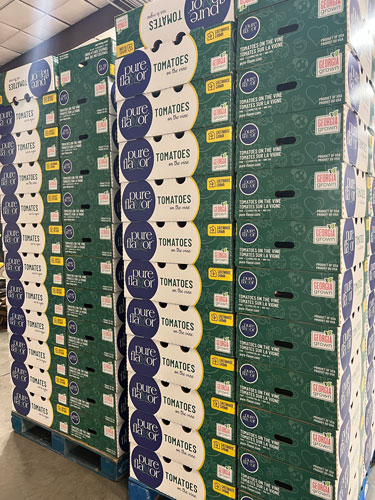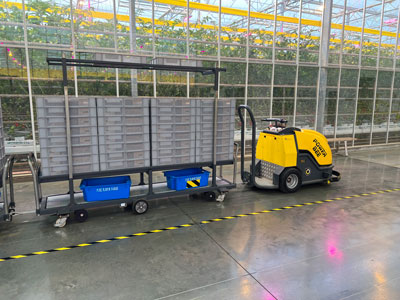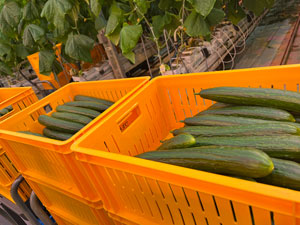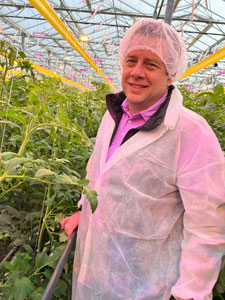5/1/2023
Firing on All Cylinders
Jennifer Polanz

Pictured: An example of the branded boxes that go to retailers. The ones that go out on display feature four-color printing and the Georgia Grown label.
On a fabulously sunny and pleasant Monday in January, I rolled up to the Fort Valley, Georgia, greenhouse growing for the Pure Flavor brand to meet Chief Marketing Officer Chris Veillon for a tour and a wide-ranging interview. The location is intentional—less than 10 minutes from the I-75 exchange that gets a truck driver to multiple major U.S. cities within hours.
Come with me as we take a peek into the 25-acre greenhouse and packhouse, and sit down with Chris to talk everything from the history of the company and expansion plans to branding (his specialty) and crop diversity.
The backstory
Every company has an origin story and this one begins with three childhood friends in Leamington, Ontario: Jamie Moracci, his brother Jeff Moracci and their friend Matt Mastronardi (yes, of the greenhouse Mastronardi family). As Chris tells the story, the three grew up together, went to university together and all had family deeply rooted in the greenhouse business (Jamie and Jeff’s dad had been part owner of a greenhouse company in Leamington).
Together they started Pure Hothouse Foods in 2003 as a sales company. They marketed product from a variety of growers, as well as a farm Matt had. The company grew over the next 13 years, marketing every type of tomato, pepper and cucumber out there. They opened facilities in Detroit and then one in San Antonio to cross-dock product coming from their Mexico grower partners. By this time they expanded their retail reach, working with major players across North America.
“But in order for the company to grow and take that next step they needed to start owning their own acreage at scale, so they opened Phase 1 in Leamington in 2016, a high-tech, 25-acre facility that was growing tomatoes and cucumbers,” Chris said. What’s next? They began looking at sites in the U.S. and considered more than 300 locations before settling on Fort Valley.
And while the benefits included the aforementioned close proximity to a major U.S. thoroughfare (fun fact: I-75 runs north-south through six states, all the way up to Sault Ste. Marie, Michigan, and all the way down to just north of Miami, Florida), there were some challenges—though none that couldn’t be overcome. For instance, the heat.
“I was fortunate enough to be here to experience what it was like building here in the thick of summer—it was like being in Hell’s kitchen,” Chris said, laughing. “The hottest day I was here I think it reached 122 degrees. That was back in the summer of 2018.”
 Pictured: This Power Bee greenhouse tow truck is automated, following a “track” through the greenhouse and packhouse.
Pictured: This Power Bee greenhouse tow truck is automated, following a “track” through the greenhouse and packhouse.
Fortunately, it’s always 70 degrees in the greenhouse. Once constructed, they added a misting system to combat the summer heat, as well as a screening system to protect the plants from not only getting burned in the summer months but to keep the energy in the greenhouse throughout the winter months. Greenhouses in Ontario have to combat cold, so it’s just a different end of the environment spectrum. The way crops are staggered, too, most are finishing up by the time the real heat kicks in. Tomatoes-on-the-vine, which take up 12 acres, finish up sometime in early summer, and cucumbers on another 12 acres go through late summer with cleanout happening in August.
… And then COVID hit
So here we are in spring of 2020 with Phase 1 of Fort Valley complete; a 60,000 sq. ft. distribution facility just opened in late 2019 in Byron, Georgia, about 10 minutes north of Fort Valley that serves as a cross-dock for product from Mexico (via San Antonio) or down from Canada to go out to the Southeast; and construction happening on Phase 2 in Leamington (now on a site of 115 acres total in 2023).
And then COVID hit.
After a brief lull, demand skyrocketed and the company hit the afterburners. “In the space of 18 months in Leamington, we tripled our acreage,” Chris said. “We completed Phase 2 in 2020 and immediately broke ground on Phase 3, another 25 acres. So we went from 25 acres of standalone to 75 acres in 18 months, all growing under lights a wide range of tomatoes and cucumbers.
Then we broke ground in early 2022 on Phase 4 in Leamington, which is to be a 40-acre high-tech lit facility.”
On top of that, they added a massive 210,000 sq. ft. distribution center and packhouse for all four phases. “So now we have this massive compound and hundreds of employees,” he added.
 Pictured: Cucumbers fresh from harvest coming back to the packhouse in trays, driven through the greenhouse via an automated cart system.
Pictured: Cucumbers fresh from harvest coming back to the packhouse in trays, driven through the greenhouse via an automated cart system.
We’re not done yet, though, as you probably know. In the fall of 2022 the company acquired DeTemporada Farms, a 25-acre bell pepper growing facility in Merlin, Ontario, Canada, where expansion is already underway. Since my interview with Chris, the company added industry veteran Joe Sbrocchi to the leadership team as Senior Vice President of Business Development & Strategy, and they announced another acquisition in late February of the Cervini Farms C5 location in Leamington that was adjacent to Pure Flavor’s multi-phase location.
I’m not a betting person, and I don’t have any inside information, but I wouldn’t bet against additional announcements before this even gets to you in May, dear reader. The future is focused on expansion of existing locations (Georgia has the potential for another 50 acres in its future), acquisition of existing high-tech facilities like DeTemporada, which was not even a year old, and expanding the grower network. All told, Pure Flavor has more than 1,000 acres under contract or that they manage in Canada, USA and Mexico.
Here’s what Chris said: “The momentum is so strong, Jen, that we’re not sitting still.”
Building that momentum
That momentum didn’t happen on its own or in a vacuum. Chris leads a marketing team of 10 to both create demand through consumer awareness and via outreach to retailers. He noted that a decade ago there were three main produce brands—Dole, Del Monte and Chiquita. Today, there are brands everywhere in the produce aisle. So how do you stand out?
“Specifically, at Pure, we developed a strategic marketing group that is focused on brand-centric marketing and that is all about building awareness for the Pure Flavor brand,” he said. “So we have a two-pronged approach—we only exist because of our sales department. Without sales, marketing doesn’t exist. So we’re there to ultimately support our sales team to make sure they have all the content they need to sell into their customers.
“On the flip side, I like to think we’re on the cutting edge, or leader of the pack, so to speak, on the brand marketing side. I’ve been in produce now 15 years and my message has not changed—I think you need to be in front of the people at the right time, on the right channel, with the right message to make sure you’re connecting with them appropriately.”
The goal is to create an emotional connection to the brand, and the team accomplishes this with photos of real people eating real product, as well as offering hundreds of recipes and robust social media and digital content offerings across many channels. They have more than 20,000 images to help tell their story, and they’ve developed more than 850 recipes over the past five years to connect customers to the product.
Chris also uses the benefit of being locally grown in Georgia by using the Georgia Grown branding. “We’re proud to be a Georgia Grown member,” he said of the program developed by the Georgia Department of Agriculture. “We’re the first greenhouse company to be built here in Georgia, so there are a lot of opportunities for firsts here. That opportunity gets us in at the ground level.
“People haven’t had a Georgia-grown tomato or cucumber in the dead of winter before. We’re in the Peach State, let’s be real. When you start talking about the value of locally grown tomatoes in the winter, it’s mindblowing to some.”
They’re getting more than that, though, with the distribution reach Pure Flavor has. Now they have access to more than just the tomatoes-on-the-vine and English cucumbers grown in Fort Valley—they can also get the peppers grown at DeTemporada or cocktail tomatoes or the company’s award-winning trademarked Cloud 9 Tomatoes grown at the Leamington campus. The access to more of the greenhouse-grown crops under the Pure Flavor name builds the brand awareness.
Not just tomatoes
Of course, if you’re talking about Pure Flavor, then you’d be remiss if you didn’t talk about melons.
“The melon program for us has been a game-changer,” Chris said. “A game-changer in the sense that we’re the first to market to do this. It was eight years of R&D to get us to this point. There was lots of trial and error, put it that way. Innovation takes time, effort and resources—we see an opportunity to not only remove the seasonality of certain items, but provide sustainable options that others never dreamed of.”
 The first introduction in May 2022 was Solara, a mini-Galia type that fits in the palm of your hand and looks similar to a honeydew inside but is sweeter. Pure Flavor worked with their seed partners to find the right melons that could be grown indoors. They weigh about a pound each and there are typically eight to nine of them on each plant.
The first introduction in May 2022 was Solara, a mini-Galia type that fits in the palm of your hand and looks similar to a honeydew inside but is sweeter. Pure Flavor worked with their seed partners to find the right melons that could be grown indoors. They weigh about a pound each and there are typically eight to nine of them on each plant.
Pictured: Here’s one of the many images the marketing team developed to promote the Solara greenhouse-grown personal melon, the first introduction with more to come.
About seven months before the packaging was finalized, the Pure Flavor marketing team focused on the sensory aspect of the product: What does it pair with? How would customers use it? How could it be used in every type of meal, from snacks to breakfast, lunch and dinner? What they knew for sure is that it would be a single, personal serving size, which had little waste associated with it.
They came up with recipes for all scenarios and lifestyle photography to accompany it (including the one you see here). With packaging, they offered it as singles and in packs of two, three and four.
The key to the whole program is it’s not one and done. They introduced Solara in May, and then Alonna, a canary melon, in October at the IFPA Global Produce & Floral Show. “Now we’re working on a couple of more that will come to life over the course of the next year, all focused on the personal aspect of it,” he said. “That’s what consumers want—something that has zero or very little waste at all, that has value in it, and our value is being greenhouse grown.”
The melon program is one example of the ways Pure Flavor is innovating to go beyond the typical tomatoes, cucumbers and peppers to advance greenhouse growing opportunities.
“What’s next? I’ve heard avocados, mangoes, all these different things,” he said of others looking outside the box. “But no one’s come to market with it yet.
“The melon program turned a lot of heads; it showed that you don’t always have to be the biggest fish in the pond to create something new and exciting. You have to have vision, you need to be passionate about the industry and ensuring consumers have access to fresh, healthy, affordable produce year-round.”
Greenhouse Keys: Automation and Cleanliness

When it comes to cleanliness, it’s vital being a tomato operation that workers and any potential visitors are thorough with sanitation protocols. That consists of stepping through a machine that cleans shoes while sanitizing hands, as well as donning shoe protection, lab coats, hair nets and other precautions. Workers sanitize door handles, equipment, trolleys and anything else they touch in one row before moving on to the next row, and before leaving one section of the greenhouse for another. Handwashing stations are prominent with thorough washing instructions in English and Spanish.
Go to https://www.youtube.com/watch?v=qfUbkNKrtsg to see more of the automation inside the greenhouses and in the packhouse, including the Power Bee automated tow truck, a sanitizing station and a system of automated conveyor belts.